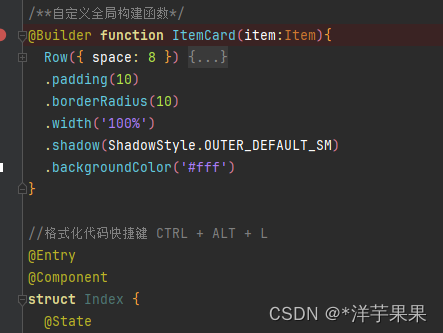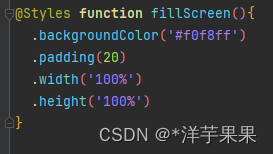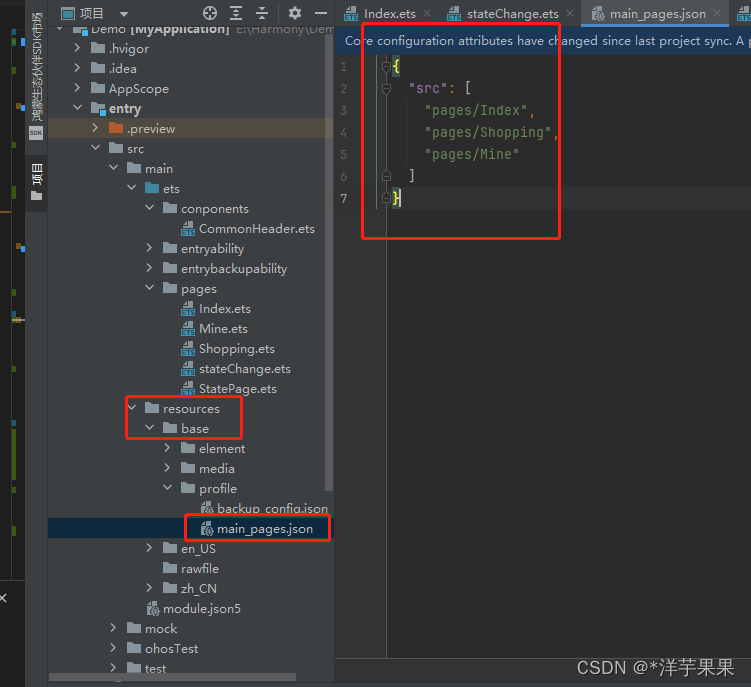一、自定义组件
1、自定义组件
自定义组件,最基础的结构如下:
@Component
struct Header {build() {}
}提取头部标题部分的代码,写成自定义组件。
1、新建ArkTs文件,把Header内容写好。
2、在需要用到的地方,导入引用即可
@Component
export struct Header {private title: ResourceStr = ''build() {Row() {Text(this.title).fontWeight(FontWeight.Bold).fontSize(24)}.width('100%').margin({ bottom: 10 })}
}import { Header } from "../conponents/CommonHeader"@Entry
@Component
struct Index {@Statebuild() { // UI描述,内部声明式UI结构Column({ space: 10 }) {Header({ title: "商品列表" })}.width('100%')}.backgroundColor('#f0f8ff').padding(20).width('100%').height('100%')}
}2、构建函数
如果是仅在该页面内部运用的组件,就可以用构建函数的方式来定义组件
分两类:全局和局部,区别就是写在struct函数外还是内,若是放在struct之内,就不需要些‘function’字段了
这样封装,就保证了代码易读易维护

3、公共样式
类似的,样式也可以这样封装


但是Styles只能封装所有组件都有的公共属性,那对于个别的如何处理呢
就需要用到Extend(注意:只能定义成全局的,不能写在struct函数内部)

二、状态管理-装饰器
1、@State
@State装饰器官网文档
@State类似于react中的UseState,只在组件内部使用
@Entry
@Component
struct StatePage {@State message: string = "hello"build() {Column() {Text(this.message).fontSize(20).onClick(()=>{this.message = '测试'})}.width('100%')}
}2、@Props
@Prop装饰器官网文档
父组件单向传值给子组件,类似于react里的props参数,可以理解为父组件参数拷贝一份给子组件
子组件数值的变化不会同步到父组件
//子组件
@Component
struct CountDownComponent {@Prop count: number = 0;costOfOneAttempt: number = 1;build() {Column() {if (this.count > 0) {Text(`You have ${this.count} Nuggets left`)} else {Text('Game over!')}// @Prop装饰的变量不会同步给父组件Button(`Try again`).onClick(() => {this.count -= this.costOfOneAttempt;})}}
}//父组件
@Entry
@Component
struct ParentComponent {@State countDownStartValue: number = 10;build() {Column() {Text(`Grant ${this.countDownStartValue} nuggets to play.`)// 父组件的数据源的修改会同步给子组件Button(`+1 - Nuggets in New Game`).onClick(() => {this.countDownStartValue += 1;})// 父组件的修改会同步给子组件Button(`-1 - Nuggets in New Game`).onClick(() => {this.countDownStartValue -= 1;})CountDownComponent({ count: this.countDownStartValue, costOfOneAttempt: 2 })}}
}3、@Link
变量与其父组件中对应的数据源建立双向数据绑定
可以理解为父组件把地址给子组件,所以改变能够同步
@Link装饰器官网文档
//子组件接收变量@Link count: number@Link costOfOneAttempt: number//调用子组件,因为是引用的方式,所以要加上$CountDownComponent({ count: $countDownStartValue})4、@Provide 和 @Consume
应用于与后代组件的双向数据同步,应用于状态数据在多个层级之间传递的场景,实现跨层级传递
就是爷爷和孙子之间直接沟通
不需要一级一级的显示传参
@Provide装饰的变量是在祖先组件中,@Consume装饰的变量是在后代组件中
感觉很方便,但一般咱不用,因为比较消耗性能
@Entry
@ComponentV2
struct Parent {@Provider() str: string = 'hello';build() {Column() {Button(this.str).onClick(() => {this.str += '0';})Child()}}
}@ComponentV2
struct Child {@Consumer() str: string = 'world';build() {Column() {Button(this.str).onClick(() => {this.str += '0';})}}
}5、@Observed 和 @ObjectLink
用于在涉及嵌套对象或数组的场景中进行双向数据同步
因为对于非简单类型,比如class、Object或者数组,是需要被@Observed装饰的,否则将观察不到其属性的变化
/**子组件定义包包的类型*/
@Observed
class Bag {public id: number;public size: number;constructor(size: number) {this.id = NextID++;this.size = size;}
}
@Observed
class User {public bag: Bag;constructor(bag: Bag) {this.bag = bag;}
}/**子组件*/
@Component
struct ViewA {label: string = 'ViewA';//被引用的类需要用ObjectLink装饰@ObjectLink bag: Bag;build() {Column() {Text(`ViewA [${this.label}] this.bag.size = ${this.bag.size}`).fontColor('#ffffffff').backgroundColor('#ff3d9dba').width(320).height(50).borderRadius(25).margin(10).textAlign(TextAlign.Center)}Button(`ViewA: this.bag.size add 1`).width(320).backgroundColor('#ff17a98d').margin(10).onClick(() => {this.bag.size += 1;})}
}
}/**父组件*/
@Entry
@Component
struct ViewB {@State user: User = new User(new Bag(0));build() {Column() {ViewA({ label: 'ViewA #1', bag: this.user.bag }).width(320)}}
}三、页面路由
把所有访问记录存在栈里,类似于出栈入栈,跳转就添加一条记录,回到上一页就是把当前记录弹出栈,就回到了上一页(ps:页面栈的最大容量是32)
如果新访问的页面是栈里存在的,把它挪到栈顶即可,这样节省空间性能
1、跳转
有两种方式:保留访问记录就用pushUrl,如果要销毁记录,就用replaceUrl
import router from '@ohos.router';
class DataModelInfo {age: number = 0;
}class DataModel {id: number = 0;info: DataModelInfo|null = null;
}function onJumpClick(): void {// 在Home页面中let paramsInfo: DataModel = {id: 123,info: {age: 20}};router.pushUrl({url: 'pages/Detail', // 目标urlparams: paramsInfo // 添加params属性,传递自定义参数}, (err) => {if (err) {console.error(`跳转失败, ${err.code}, ${err.message}`);return;}console.info('跳转成功!');})
}2、回到上一页
返回用即可
import router from '@ohos.router';
//回退到指定的home页
router.back({url: 'pages/Home'
});
//不传参,即是回退到上一页
//router.back();3、综合小案例
跳转到对应页面

如果新建页面时,选择的是新建page,则自动配置路径,若是选择ArkTs,则是没有的

import router from '@ohos.router';class RouterInfo {url: stringtitle: stringconstructor(url: string, title: string) {this.url = url;this.title = title}
}@Entry
@Component
struct Index {@State message: string = '页面列表'private routers: RouterInfo[] = [new RouterInfo("pages/Shopping", "商品"),new RouterInfo("pages/Mine", "我的"),]build() {Column() {Text(this.message).fontSize(30)List({ space: 15 }) {ForEach(this.routers,(router: RouterInfo, index) => {ListItem() {this.RouterItem(router, index + 1)}})}}.width('100%')}@BuilderRouterItem(r: RouterInfo, i: number) {Row() {Text(i + '.').fontSize(20).fontColor(Color.White)Blank()Text(r.title).fontSize(20).fontColor(Color.White)}.width(120).padding(12).backgroundColor('#38f').borderRadius(20).onClick(() => {router.pushUrl({url: r.url,params: i},router.RouterMode.Single,err => {if (err) {console.log(`跳转失败${err.message}${err.code}`)}})})}
}写在最后,可结合Harmony_鸿蒙专栏阅读


Plan Resoure Management)






——catia文档操作vb.net程序案例,打开catia文件,进行视图操作,退出程序)









